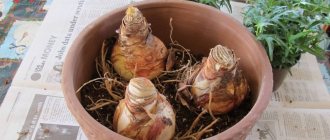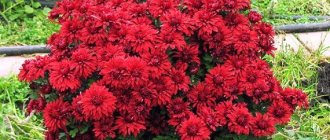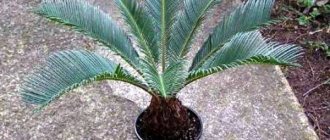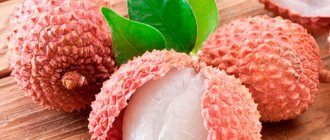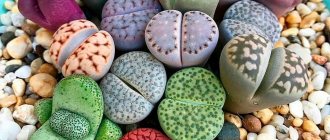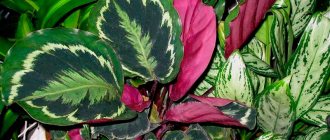Propagation by seeds at home
Euphorbia is propagated by seeds at the end of summer , when seed pods appear, but it can also be sown in the “classical time,” that is, in the spring (the specific time depends on the region and is not related to temperature, but to the length of daylight hours).
Advantages and disadvantages
The method is simple, does not allow preserving varietal characteristics, so it is not suitable for those who plan to propagate plants of a certain variety, and is not so profitable when growing for sale.
How to choose seeds?
Seeds can be collected independently from a crop or purchased in a store . Seeds are taken from a healthy plant; they must be undamaged, not empty, not overdried.
Step-by-step instructions: how to plant?
- The seeds are buried in moist soil; several seeds are placed in one pot.
- The choice of further actions depends on preferences.
Some plant growers claim that subsequent compliance with the microclimate and soil cover is not required, while others recommend creating a microgreenhouse by covering the top of the pot with glass/polyethylene/cut plastic bottle.
How to grow seedlings and when to plant?
Seedlings are grown at normal room temperature, but not lower than 20 degrees with sufficient light. When the first shoots appear, the covering material is removed .
Watering corresponds to the drying of the soil; do not forget that this is not a moisture-loving plant. It is necessary to spray, especially if the room is dry.
Transplantation of seedlings to a permanent place is done when 2-3 leaves appear, when the sprouts have finally become stronger.
Description and characteristics of the plant
Euphorbia, or Euphorbia, has 160 greenhouse species, which differ in the range of flowering and even the type of plant. These are perennial and annual euphorbias, shrubs, herbs, cacti and succulent representatives. Most of them have a fleshy, succulent stem, firmly rooted in the soil. The trunk is straight or ascending, weakly branched, from the mundane type to 2 m in height. Some species are leafless and without thorns, the rest have spines and thorns. The rhizomes are creeping and ascending, and the leaves are found in all types.
Euphorbia most often blooms with monoecious flowers in the spring or in the first half of summer in yellow, light green, pink, red, white, orange (there are also non-flowering representatives). Some species produce fruits in the form of a three-housed nut with seeds. The milky sap has an pungent taste and poisonous properties, so livestock avoid it. The plant is native to the subtropics of Latin America, the tropical zones of the islands of Madagascar and Abd el-Kuri, and archipelagos in the Indian Ocean.
Cuttings
The perennial is propagated by cuttings or by dividing the mother plant in early or mid-spring in order to have time to separate the planting material from the plant before active growth of milkweed begins. The choice of such a time is not accidental - in this way the possibility of a stressful situation can be eliminated, in the light of which the plant could get sick or die.
Some gardeners prefer to divide perennials in early autumn to give the young crop more time to adapt and take root.
Pros and cons of the method
The advantages include the fact that the method makes it possible to preserve the varietal characteristics of the plant in its “new life”; the disadvantages are the need to take a fairly large fragment, which can adversely affect the appearance of the “donor”.
How to prepare cuttings?
Planting material is taken from the healthiest and most beautiful plant . It is better not to touch young plants, but to take cuttings from an adult perennial.
How to root a shoot?
Cuttings are carried out in several steps.
- A shoot at least five centimeters long is taken from a healthy plant. The cut area on the plant does not need to be treated.
- The cuttings can be rooted immediately or allowed to dry for 1-2 days. Rooting is done immediately in a permanent container, so as not to replant and stress the plant later.
- The soil needs to be well moistened (but do not overdo it, otherwise rotting may occur), after which the plant is covered with film or glass to create a microclimate.
- It is necessary to maintain a constant temperature of at least 20 degrees and sufficient lighting. As a rule, rooting occurs after 2-3 weeks.
Diseases and pests of milkweed
Euphorbia has a strong immunity to most major plant diseases. Although some known pests can also have a negative effect on the plant. The most dangerous enemy of milkweed is the mealybug. When a white coating appears, you should wipe the entire affected part of the plant (if it is not a succulent, but the leaves, too, both above and below) with water and alcohol or a solution of laundry soap.
Thrips, aphids, some types of fungi and spider mites can also cause problems in some varieties of milkweed:
- Spraying with tincture of garlic with alcohol, treating with mustard and onions helps against aphids.
- A solution of laundry soap and a solution of alcohol will help get rid of the tick.
- Store-bought fungicides can help control fungi.
If you water, feed, replant euphorbia correctly and on time and keep it on a clean windowsill, where regular cleaning is constantly carried out, your plant will not be afraid of any diseases and it will grow happily on your window for a long time, delighting the eyes of outside observers.
How to propagate by dividing a bush?
Euphorbia can also be propagated by dividing the donor plant . In this case, “good health” is also necessary, as well as the presence of several trunks.
As practice shows, separated parts quickly adapt to new conditions and continue development in a separate container.
Advantages and disadvantages of the method
One of the advantages is good survival rate . The disadvantages include the fact that only bush varieties are suitable for this method; in other cases, only propagation by cuttings is suitable.
How to choose and prepare a bush?
No special preparation is required. As in all other cases, it must be an “exemplary in all respects” bush in terms of appearance and condition. Before dividing, the soil is watered; the procedure is carried out carefully so as not to damage the roots and the plants themselves, since some of the varieties are easy to break.
Step-by-step instructions for rooting
The procedure is simple and is performed in several steps.
- An adult euphorbia along with a lump of earth is removed from the pot, excess soil is removed to a minimum, and the condition of the root system is simultaneously checked.
- Then the shoots are carefully separated. It is optimal to take two to four new plants (depending on size and age).
- Each shoot takes root in a separate container with prepared soil of the composition indicated at the beginning of the article. The shoots need some time to recover from stress and adapt to new conditions, so growth will not be as vigorous at first.
Pest and disease control
Euphorbia is a very convenient plant for growing at home, resistant to most diseases and pest attacks. The danger is mainly from improper care and excessive watering of the plant , which leads to the formation of rot or the growth of fungus and mold on the surface of the earth.
In this case, it is necessary to replant the spurge or remove the top layer of soil, sprinkle with crushed activated carbon or ash, and then place new clean soil and completely stop watering the plant for a week.
When rot and fungus appear, the top layer of soil in the pot with milkweed is removed and crushed activated carbon is added.
In the future, you should carefully resume adding moisture in small portions to give the root system time to adapt and start working well. Fertilizing the affected plant during this period is strictly prohibited.
If cobwebs appear between the leaves, you should immediately isolate and wash the plant with a warm, soapy solution of natural laundry soap. After 10 days, it is advisable to repeat the procedure to prevent the spread of spider mites.
Features of breeding in open ground
- Growing euphorbia in open ground will not cause much trouble.
But only garden species of milkweed are suitable for this, and these are mostly perennials. The plant feels good in sunny places and in partial shade, although in the latter case it does not bloom so profusely, so such areas are more suitable for decorative deciduous varieties that can be grown as a “carpet”. - Even indoor spurge propagates well by seeds sown, as a rule, in the spring, and when carried by the wind they easily sprout anywhere in the area.
Having discovered such seedlings, you can dig up the plant and transplant it where you need it, although, despite its unpretentiousness, the plant does not like replanting and takes a long time to adapt, lagging behind bushes sown with seeds in growth. - In warm regions of the country, annual milkweed seeds are sown in early spring, in colder regions - through seedlings or sowing seeds before winter (late autumn), they will undergo natural stratification and grow stronger.
A month after the sprouts appear, the plant can be replanted, or, if sowing was already done in a permanent place, the plantings are thinned out. Planting of finished seedlings in the ground occurs when the threat of frost has passed. When planting using the division method, time does not matter. Some varieties require the installation of a support to which the seedling is tied after planting. The pruning rules are simple, shoots are removed as needed, this will stimulate re-blooming at the end of the season. - The bushes are fed once or twice a season with mineral fertilizers for garden plants, but you can also take those intended for indoor plants. Most varieties of euphorbia tolerate winter well without shelter, but in cold regions it is better to cover the bushes with spruce branches, sawdust, and covering material.
Popular varieties of milkweed
Euphorbia has many varieties that can be grown at home. Therefore, before planting this cactus, you need to find out which varieties are best to plant.
Ribbed or comb
It is a green stem shrub whose trunk has a ribbed surface. The height of the comb variety is one and a half meters. The plant is most often found in coastal and subtropical forest areas in Madagascar.
Over time, miniature yellowish flowers form on the bush. The diameter of each of them does not exceed three centimeters. Ribbed spurge blooms in the first half of summer. Flowering lasts 20-30 days. Among the main features of the ribbed plant are resistance to frost, as well as protection from pests.
Belozhilkovy
It is considered one of the most common varieties of milkweed, grown by many gardeners. In nature, such a plant grows up to two meters without problems. Indoors and in a pot, the maximum height is 120-130 centimeters. The trunk of the white-veined variety also has irregularities on the surface. The foliage is bright green with thin white veins.
The flowers of such a seedling are not easy to notice, since they are located under the leaves. They have yellowish petals and bloom in June or July.
mile
This is a tall variety that, in suitable conditions, grows up to two and a half meters. The bush has many branched stems of a grayish color. The leaves are located at the top of the shoots. Their length reaches four centimeters and their width does not exceed two centimeters.
The main distinguishing feature of Mili is considered to be the bracts, which are brightly colored. Their surface can be painted yellow, orange and scarlet. The flower is in small orange inflorescences. Milya, like most other varieties, blooms in summer.
Head of Medusa
Decorative medium-sized spurge that grows well in pots. If you properly care for the planted seedling, its height will reach 130-145 centimeters. In this case, the diameter of the main stem is 20-25 cm.
The medusoid variety has many lateral branches on the trunk, which can be either short or long. The central part of the trunk is slightly thickened, it accumulates nutritional components and moisture that comes through the root system from the soil. Medusa's head blooms at the end of May or early June.
Beautiful or poinsettia
A popular flowering milkweed that is native to central America and southern Mexico. This variety is considered one of the most compact, as the bush grows up to fifty centimeters. Greenish leaves with an ellipsoid shape form on the stems of the bush. On the edges of each of the leaves there are serrations, which make the leaves more unusual.
The distinctive features of this milkweed include its unusual flowers, which can be painted in any color. Most often there are plants with red, yellowish or burgundy petals.
Enopla
A low-growing succulent plant that can be grown in small pots. Enopla bushes grow up to 30-35 centimeters; small red thorns with a slight purple tint grow on the main stem. Miniature reduced leaves with a green surface are formed on the stems.
See also
Types and varieties of spirea with descriptions and characteristics, growing rulesRead
Two types of flowers are formed on the plant:
- men's;
- women's
Enopla flowering begins in the summer and lasts 2-3 weeks.
Fat
This plant variety looks like a small cactus. The plump seedling has a spherical shape. Leaves or spines do not form on it; instead, compact branches in the shape of spheres appear on the plant. The diameter of the main stem is 5-8 centimeters, and the height is 15-30 cm. At first the trunk is octagonal, but over time its shape becomes more rounded.
Fat spurge can have a gray, greenish, steel, purple and even brown color. You can also see transverse multi-colored stripes on its stem.
Photo
Next, you can see in the photo what milkweed flowers look like when properly planted and cared for.
Undoubtedly, spurge is a very original and unusual plant. And every gardener wants to see this handsome man on his windowsill or in the garden. But many people have a question: can it be kept at home, why is spurge dangerous? For those who doubt whether or not to purchase this plant, we have prepared publications about the benefits and harms of milkweed.
What to consider before purchasing a flower
Before purchasing a flower, you need to familiarize yourself with the conditions in which it is best to grow it.
Location and lighting
The cultivation of euphorbia seedlings should be carried out in a suitable place. Many varieties of this plant are light-loving and therefore should be grown on windowsills that receive direct sunlight. However, the most beautiful variety loves diffused lighting more and therefore care must be taken to ensure that the rays of the sun do not fall on it.
This plant can also be grown in a shaded place where there is practically no light. In this case, the leaves will have a less bright color, which is why they will lose their attractiveness.
Optimal temperature conditions
When growing milkweed, you must adhere to a temperature regime that promotes plant growth. Experts advise growing it at temperatures from 15 to 27 degrees above zero. In summer, the plant is taken outside, into the sun. In the evening, when the temperature drops below 14-16 degrees, he is brought into the room.
There are varieties of milkweed that tolerate temperature changes. They can grow at temperatures of 5-7 degrees. However, at such temperatures, the container with the flower must be placed in a lighted place.
Humidity
Some people believe that spurge bushes must be grown in conditions of high humidity, but this is not so. The plant tolerates drought, and therefore the humidity level in the room with milkweed should be average. However, the plant will grow well even in high humidity.
Required soil composition
Before planting spurge, you should understand the optimal composition of the soil. It is the soil and the components that make up it that influence the further development of the planted bush.
Flower growers with many years of experience recommend growing seedlings in permeable and loose substrates. This type of soil is ideal for growing milkweed. If you were unable to purchase a soil mixture for succulent-type plants, you can independently prepare a composition for growing cacti. To do this, mix sand with humus and soil in equal quantities.
Pot size
In order for planted spurge to grow well, you need to choose a suitable container for it. Some people use boxes for planting milkweed, but most often people use pots. In this case, containers must be changed as the plant grows. Experts advise replacing the potty annually.
See also
Planting, growing and caring for the Vanka Wet flower at homeRead
First, the seedlings are planted in small pots 10-12 centimeters deep. However, when the root system grows, you will have to prepare larger containers. Mature milkweed seedlings should be grown in pots whose depth is 17-25 centimeters.
How to care for the first time?
A plant propagated by any method requires provision of normal conditions. In order for euphorbia to take root faster and actively begin to grow, the location and light parameters must be correctly selected.
Tolerates sunny places well, but without contact with sunlight , but drafts are also undesirable. Window sills on the side with a moderate degree of lighting work well.
If the plant is in the shade, then in winter it may need additional illumination with a phytolamp, but the type of milkweed also matters here; some varieties tolerate the lack of light better, and some - worse, although flowering species may stop blooming in such cases.
Euphorbia does not like excess humidity and abundant watering , this can cause deterioration of the condition. Indoor spurge should be watered more only during the period of active growth and if the air in the room is dry, and garden species - in dry summers.
The same applies to spraying. Excess moisture can be recognized by a change in color to a paler color and a decrease in the number of leaves.
However, complete drying out of the soil should also not be allowed . There are no strict temperature requirements; the plant tolerates a wide range of temperatures (from 16 to 24), however, sudden changes should be avoided.
In the warm season, you can keep it on the balcony, terrace, veranda, but you should not take the spurge there during the hot period, you need to accustom it to street conditions gradually.
A young plant needs periodic feeding.
The optimal solution is a complex fertilizer for succulents , which can be used year-round. Feeding is carried out no more than once every two months in winter and autumn, once a month in spring and summer.
Garden species are fed twice or thrice a season with mineral fertilizers.
In autumn, it is recommended to mulch plants (peat, humus, sawdust), and in cold regions to cover them for the winter (spruce branches, covering material, polyethylene, etc.). The need for pruning depends on the variety.
Correct pruning allows you to form a beautiful crown and increase the lushness of the bush, but if you have no experience in this matter, then it is better not to experiment, otherwise the plant will have to be thrown away, since it is difficult to correct unsuccessful pruning of milkweed due to the not very lush crown.
Faded buds and dried leaves must be removed . Young plants are replanted annually, each time increasing the volume of the pot.
The soil is selected depending on the variety, but the variations in composition are not too different. Both flowering and decorative foliage varieties can be grown in a universal substrate. It is recommended to replant adult plants every three to four years. Rooting is most effective in the spring.
All the features of caring for milkweed are described in detail in this article.
As a conclusion, we can say that growing milkweed is not difficult (if only for beginners), but it looks quite attractive and will fit harmoniously into any interior, and there is a place for it in the garden that it will transform.
Conditions for keeping the plant at home
Due to the diversity of this plant, we can highlight some common characteristics of keeping unpretentious indoor species at home.
Lighting
Euphorbia is an indoor flower (a photo of an exotic plant conveys its main features), requiring bright light and direct sunlight, therefore it is perfectly suited for southern or western windows.
With poor, insufficient lighting, the plant can slow down its growth and become very elongated. To prevent this, you can periodically illuminate it with a phytolamp.
Temperature
In the summer, with a lot of sunlight, temperature does not play any role; the heat-loving plant tolerates heat up to +30°C and above.
But in the dark winter months, it is advisable for the plant to provide a slight decrease in temperature to +10-+15°C, which will lead to a slowdown in growth and preserve the attractiveness of adult milkweed. At this temperature, flower buds are formed, which is important when breeding decorative flowering species.
Euphorbia (flower - photo) - heat-loving plant
This unpretentious flower easily tolerates temperatures down to +5 °C, so it can be grown in greenhouses and winter gardens, and taken out into the open air in summer.
Humidity
Euphorbias are perfectly suited to the dry air of city apartments, in which they can grow magnificently without additional moisture.
Spraying on very hot days should be carried out with great caution , and at low temperatures, especially in the presence of even light drafts, this procedure may be completely contraindicated for this type of indoor plant, as it can provoke rotting of the stem or the development of a fungal disease.
Soil and drainage
The plant requires good permeable drainage, which can be used:
- bulk layer of large expanded clay;
You can purchase ready-made soil for planting milkweed
- ceramic fragments or brick chips;
- pieces of charcoal;
- a layer of well-washed river pebbles;
- large pieces of foam.
For unpretentious plants, you can purchase a balanced soil for succulents or make a light, permeable substrate yourself, which should include in approximately equal proportions:
- humus;
- turf land;
- sand;
- peat or leaf litter.
The volume of the flower pot is selected according to the size of the plant roots.
The volume of the flower pot must be selected according to the size of the root system. You should not take dishes that are too spacious, as the soil may become sour. The planting container must have a drain hole through which excess water and additional respiration of the roots will freely flow out.
Watering
Like all succulents, milkweeds store moisture in their fleshy stems for a long time, so they do not need frequent watering, and with prolonged excess moisture in winter they may even die.
The optimal watering regime for adult plants is the following:
- in winter, it is enough to water spurge once a month or every 3 weeks;
- from March you can increase the frequency of soil moistening to 2 times a month;
- during the hot summer months, you can water the plant once a week.
It is strictly forbidden to allow water to stagnate in the pot. The individual characteristics of each plant should be taken into account and the soil should not become acidic.
It is advisable that the surface layer of soil between waterings has time to dry to a depth of 2-3 cm.
What does milkweed look like?
Varieties of milkweed differ very noticeably from one another. Some of them have ordinary stems with foliage and without sharp protrusions, others have stems overgrown with both foliage and thorns, and others are distinguished by massive stems resembling a column, with sharp growths and without foliage, for example, Euphorbia multiflora. All varieties of this plant contain juice in their tissues, which accumulates in the vascular system.
Is milkweed poisonous or not?
Growers praise all types of milkweed for their aesthetic appeal and ability to grow without constant care. However, once you place such a bush in a room, you must handle it with extreme caution, since it is poisonous and extremely harmful. Despite all their differences, plants of this family also have a common feature. The liquid in them is poisonous, and belongs to the category of the most dangerous poisons of plant origin. Euphorbia in the garden is not so dangerous.
